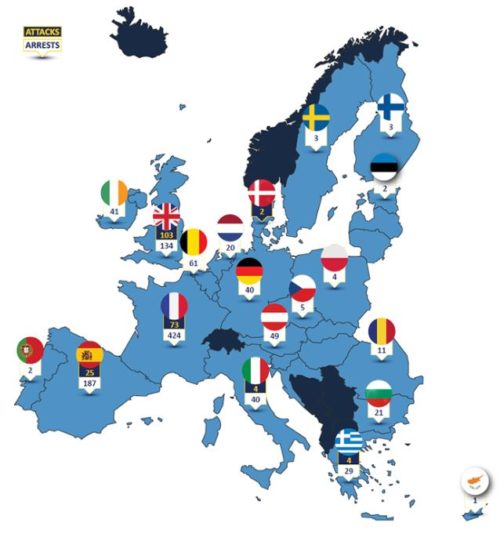
The Hague, the Netherlands
In 2015, 151 people died and over 360 were injured as a result of terrorist attacks in the EU. Six EU Member States[1] faced 211 failed, foiled and completed terrorist attacks. 1 077 individuals were arrested in the EU for terrorism-related offences, of which 424 in France only. 94% of the individuals trialled for jihadist terrorism were found guilty and prosecuted[2] .

Figure 1: Number of failed, foiled or completed attacks; number of arrested suspects 2013 to 2015
This general overview is an important part of the EU Terrorism Situation and Trend Report (TE-SAT) 2016, which Europol releases today. In addition, Europol releases a brief assessment of recent terrorist incidents that highlights the operational difficulties in the detection and disruption of lone actor attacks. In the TE-SAT 2016, Europol stresses that such attacks remained a favoured tactic by the Islamic State and al-Qaeda, and both groups have repeatedly called on Muslims living in Western countries to perpetrate lone actor attacks in their countries of residence. Rob Wainwright, Director of Europol: “In 2015 the European Union experienced a massive number of casualties caused by terrorist attacks. In this context, Europol made use of its unique capabilities to focus on supporting operational investigations to prevent terrorist attacks and identify and disrupt terrorists. The increased cooperation resulted in a much richer strategic intelligence picture, strengthening the 2016 TE-SAT report and Europol’s ability to advise political leaders and legislators and inform national authorities in the setting of threat levels.” The TE-SAT 2016 outlines two worrying developments: the overall threat is reinforced by the substantial numbers of returned foreign terrorist fighters that many Member States now have on their soil, and the significant rise in nationalist (xenophobic), racist and anti-Semitic sentiments across the EU, each resulting in acts of right-wing extremism. The report brings to light the fact that a significant percentage of all foreign terrorist travellers in Syria/Iraq are now female. On the other hand, there is no concrete evidence to date that terrorist travellers systematically use the flow of refugees to enter Europe unnoticed. The investigations into the 13 November Paris attacks revealed however that two of the attackers had entered the EU through Greece as part of the large influx of refugees from Syria.

Figure 2: Terrorist attacks and arrests in the EU in 2015
Europol took immediate action to help the Member States tackle these challenges e.g. by establishing the European Counter Terrorism Centre (ECTC), adapting its databases and secure information exchange networks to the new needs of law enforcement agencies and setting up 24/7 response teams. 2015 was a year of legislative change for EU Member States. In order to strengthen the fight against terrorism, 12 Member States either adopted new laws or amended the existing legislation. The report, which Europol has produced on an annual basis since 2006, provides an overview of the failed, foiled and completed terrorist attacks that took place in the EU during 2015, and of arrests, convictions and penalties issued. The TE-SAT also categorises terrorist organisations by their source of motivation. However, many groups have a mixture of motivating ideologies, although usually one ideology or motivation dominates. It is worth noting that a categorisation of individuals and terrorist groups based on the ideology or goals they espouse should not be confused with motivating factors and the paths to radicalisation. This TE-SAT has been produced by Europol analysts and experts, drawing on contributions from EU Member States and external partners like Iceland, Norway, Switzerland and Turkey.





